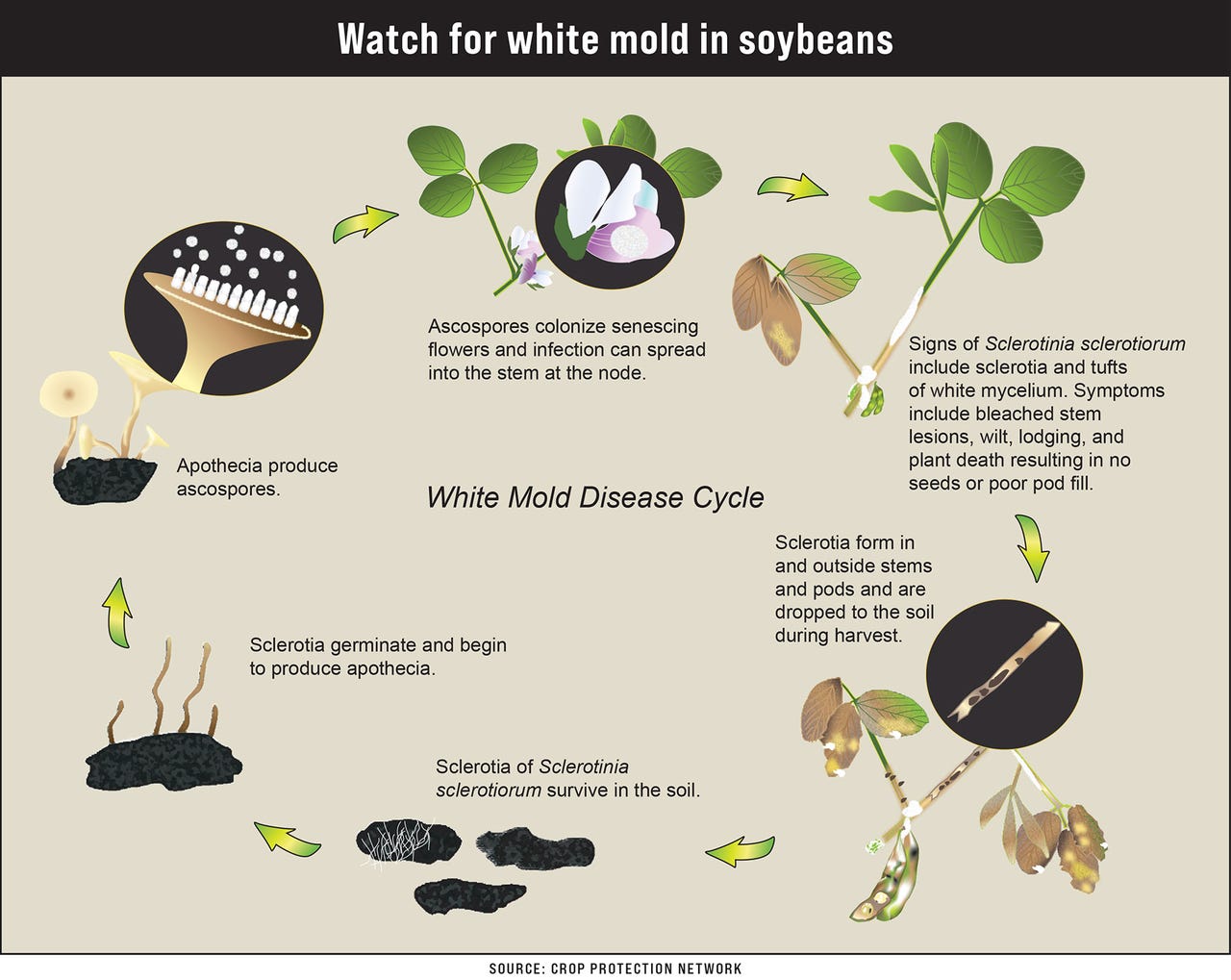The heat might be on now, but a lot of rain has fallen this spring, and if you were able to plant soybeans early, be on the lookout for white mold.
“This feels like a white mold year. If you know you have a while mold problem, you just plan on a fungicide application at R1,” says Eric Rosenbaum, owner of Rosetree Consulting. “You pick a fungicide molecule that is effective on white mold, you position it right at R1, you go out and make that application, and then 10 to 14 days reevaluate, and if your conditions are still high risk, go make a second.”
What is white mold?
According to the online Crop Protection Network, white mold is caused by the fungus Sclerotinia sclerotiorum. It is often identified by fluffy, white growth on soybean stems. Initial symptoms develop from R3 to R6 as gray-to-white lesions at the nodes. Lesions rapidly progress above and below the nodes, sometimes girdling the stem.
Characteristic black sclerotia will eventually become visible and be embedded within the mold on stem lesions, and inside the stem as the plant approaches death.
Pods affected by white mold generally contain seeds that are smaller, lighter, white and cottony.
The fungus survives in the soil for several years as sclerotia, especially in systems that are no-till or minimum till.

Weather and timing matter
It’s been a wet spring with cool temperatures and high humidity. This favors white mold development, especially if soybean plants are starting to flower.
Flowering can last several weeks, so as long as there are soybeans flowering and weather conditions are right, this raises the risk for white mold development.
Why it matters
According to Corteva Agriscience, yield losses begin with as little as 15% disease incidence, and with each additional 10% increase of disease incidence, an estimated yield loss of 2 to 5 bushels per acre can occur.
White mold can even destroy a soybean crop in infested fields when there is a dense canopy with prolonged periods of wet weather.
Flowering is happening
Paul Esker, professor of field crop pathology at Penn State, says flowering has already been seen in some research fields in Lebanon County, Pa.
This week’s heat may help keep the disease in check in some fields, but he also points out that even in drought, there has been white mold found because inoculum has been built up over several years.
“There’s no silver bullet. The realism is that if you have a history of it, you’re going to have some risk. The idea is to maintain it at the lowest levels possible,” Esker says. “We can still handle 10% to 20% incidence in fields, so think 10 plants out of a 100 with symptoms. But you can maintain yield potential because of great modern varieties.
“It’s all about inoculum management … just trying to knock it back because all it takes is one fruiting body in a yard that can produce enough spores to cause infection. Our goal is to keep inoculum at a really low density,” he adds.
Action plan
R1 has traditionally been the time to spray for white mold, but Esker says you can push it out to R2 or even R3 depending on severity, and if you’re using a two-pass system.
“Last year in some research fields, we saw the most bang for our buck from a second pass, not the first,” he says. “I’d say nail the growth stage first, and then try to figure out the decision-making process, whether it’s a one-pass or two-pass. But I know we’ve started to see even our later applications maybe hold up a little stronger than that early application.”
Michigan State Extension lists the following fungicides as providing good to very good management of white mold when properly applied:
- Approach 2.08SC (good to very good, based on two applications: R1 and R3)
- Endura 0.7DF (very good)
- Lektivar 40SC (good)
- Omega 500DF (good)
- Propulse 3.34SC (good)
It also has sprayer information for best coverage:
- Apply 15 to 20 gallons of water per acre.
- Adjust nozzle pressure to about 40 psi.
- Maintain ground speed at 10 mph or less.
- Equip the boom with nozzles that produce a single flat fan spray pattern directed straight down into the canopy in large, dense canopies.
- Select nozzles that generate fine-to-medium droplets under the parameters listed above. Fine to-medium droplets have volume median diameters ranging from 200 to 350 microns.
- Use the midpoint in the crop canopy as your target in shorter plants, and 5 inches below the top of the canopy in tall plants. Adjust the boom height from this point as recommended by the nozzle manufacturer for the spacing and spray angle of your nozzles.